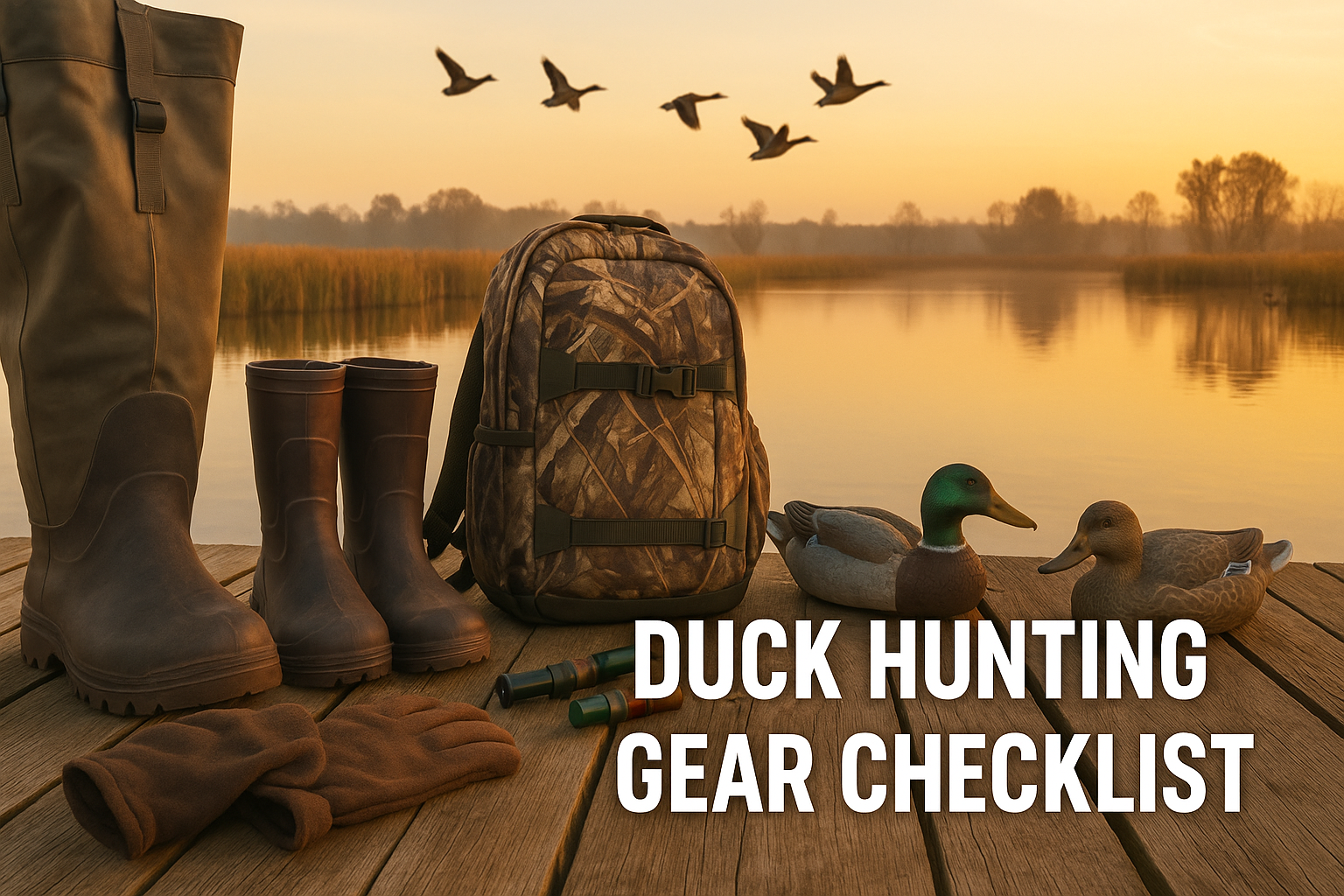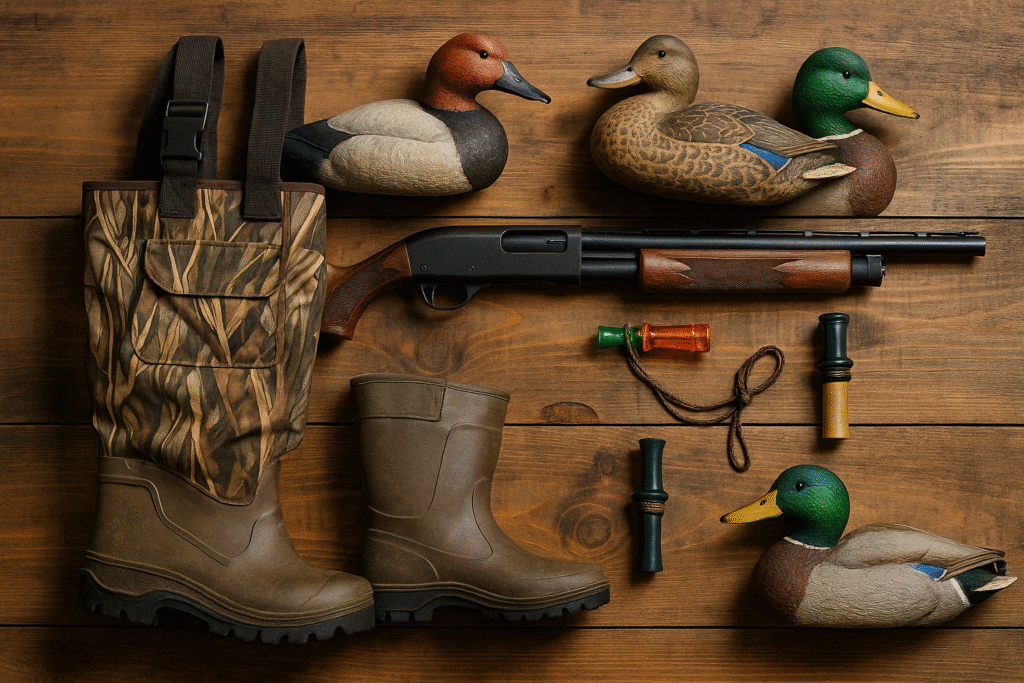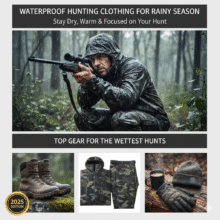Duck Hunting Gear Checklist: Must-Have Items for Every Season

A successful duck hunt isn’t just about calling birds into range. It’s about being prepared for the conditions, understanding the habits of waterfowl and having the right equipment to stay safe, concealed and effective. The weather can vary dramatically over the course of a duck season, from balmy early mornings in September to bitterly cold days in January. A versatile gear kit helps you adapt to rain, sleet, ice and heavy winds. It also ensures that you comply with regulations, stay comfortable and avoid those small mistakes that can ruin a hunt.
his guide lays out a comprehensive checklist of duck hunting gear for every season. Whether you are a beginner putting together your first blind bag or a seasoned hunter looking to refine your setup, the following sections outline what you need to bring along and why. It covers firearms and ammunition choices, clothing and camo options, decoys and calling equipment, boats and dogs, safety items and season‑specific considerations. Two excellent resources with further advice on gear include the Captain Experiences duck hunting essentials guide and the gear checklist from N1 OutdoorThese external articles articles provide additional insights into choosing gear and are worth a read if you want more detail.

Understanding Duck Hunting Seasons
Waterfowl seasons are structured around migration and climate. Early season (late summer to early autumn) often features teal and resident ducks. Temperatures may still be mild, and vegetation is lush and green. Mid‑season (late autumn) brings a mix of resident and migrating birds as cold fronts push northern ducks south. It is characterized by cooler days, leafless trees and increased precipitation. Late season (winter) is usually the coldest period, with snow and ice on the water, strong winds and wary ducks that have been hunted hard for months.
Understanding these seasonal shifts helps you tailor your gear. Lightweight, breathable clothing works well in early season, while heavier insulation and neoprene waders are vital in late season. Decoy spreads and calling strategies also change as birds become more educated. The following equipment categories are organized with seasonal adaptability in mind.
Firearms and Ammunition
Selecting a Shotgun
Your shotgun is the foundation of your duck hunting kit. Most hunters favor a 12‑gauge because it strikes a balance between power and manageable recoil, and it handles a wide variety of load sizes. A 20‑gauge is lighter and can be adequate for close‑range teal or small ducks, but it offers less pellet density. Pump‑action guns are renowned for reliability, especially in wet conditions. Semi‑automatics cycle faster but require more maintenance to keep them functioning smoothly. Regardless of your choice, regulations require your shotgun to be plugged so it holds no more than three shells. Make sure you test your firearm before the season and clean it thoroughly after every hunt.
Choosing Ammunition
Lead shot is prohibited for waterfowl hunting, so you must use non‑toxic loads such as steel, bismuth or tungsten. Steel is the most common and cost‑effective, though it drops energy faster than denser alternatives. Bismuth and tungsten retain more downrange energy and allow you to shoot smaller shot sizes, but they are pricier. Many hunters prefer No. 4 or No. 3 steel for ducks and BB or No. 2 for geese. Pattern your gun with several brands to see what it shoots best. Keep at least a box of shells for each hunt and carry extras; misfires or lost birds can quickly deplete your supply.
Chokes and Accessories
Interchangeable choke tubes let you modify your shot pattern. Open chokes (improved cylinder) are useful for close early‑season teal, while modified or full chokes provide tighter patterns for late‑season birds and longer shots. A good sling makes it easier to carry your shotgun on long walks or when wading. A soft or hard case protects your firearm during travel and keeps mud and water out. Cleaners and lubricants belong in your blind bag to help you maintain the gun if it gets dunked.
Clothing: Staying Dry, Warm and Concealed
Waterfowlers spend long hours sitting still in wet, windy conditions. Proper clothing will keep you comfortable, which translates into patience and success.
Waders
Waders keep you dry when setting decoys, retrieving birds or crossing flooded fields. Breathable waders are lighter and more comfortable in warm weather. They allow moisture to escape but block water from entering. For late season hunts, insulated neoprene waders provide much better warmth. The N1 Outdoors gear guide notes that some waders come with built‑in insulation, making them essential for cold weather. Look for models with reinforced knees and gravel guards to prevent leaks. Hip boots or knee‑high rubber boots can suffice for field hunts or shallow water in early season. Always carry an extra pair of socks in case your waders leak.
Jackets and Outerwear
A good duck hunting jacket should be waterproof and windproof. Many modern jackets use breathable membranes with adjustable hoods and cuffs. Insulated parkas are ideal for late season hunts, while lightweight shells paired with base layers are better in early season. Multiple pockets provide space for shells, calls and hand warmers. Packable rain jackets are handy for sudden downpours.
Gloves and Hand Protection
Cold, wet hands make loading shells or operating a call difficult. The N1 Outdoors checklist emphasises that gloves are an essential part of any duck hunting outfit. Neoprene gloves offer excellent warmth and water resistance in cold weather. Thin synthetic gloves work well in early season, providing dexterity for calling and shooting. Keep a spare pair in your bag; once gloves get soaked, they lose insulation.
Headgear and Face Protection
A warm hat or beanie is critical for heat retention. In early season, a breathable cap with a brim shades your eyes and reduces glare. In colder weather, fleece or wool beanies with windproof liners prevent heat loss. Face masks or balaclavas provide camouflage and protect your skin from windburn. Some hunters prefer face paint for breathability, but you may still need a neck gaiter to ward off chill.
Base Layers and Insulation
Layering is the key to comfort in fluctuating weather. Start with moisture‑wicking base layers that draw sweat away from your skin. Synthetic or merino wool long underwear works well for both early and late seasons. Add insulating layers like fleece or down for mid‑ and late season. Avoid cotton; once it’s wet, it no longer insulates.
Camouflage and Concealment
Ducks have keen eyesight and can pick out unnatural shapes and movement. Blending into your surroundings involves both clothing and your hide.
Camouflage Patterns
Choose camo patterns that match the environment you hunt. Marsh grasses and cattails require browns and tans, while timber hunts benefit from patterns with bark and leaf motifs. In snowy late‑season conditions, opt for white or snow camo outer layers. Always minimize shiny surfaces on your gear; reflective buckl

Blinds and Natural Hides
A good hide is often more important than the type of decoys you use. The Captain Experiences guide notes that constructing or using a proper blind is critical because birds will flare if they see you. Blinds range from permanent pit blinds to portable layout blinds or simple brush blinds. Portable layout blinds are effective in fields; they’re lightweight and fold up for transport. Boat blinds allow you to hide within your craft on open water. Whatever you use, brush it in with natural vegetation from the area. Many hunters carry zip ties or clips to attach grass or reeds. If you don’t have a blind, position decoys close together and hide among them, using natural cover as much as possible.
Decoys: Variety, Numbers and Spreads
Decoys attract birds by simulating a safe place to land. Their effectiveness depends on species, realism and placement.
Types of Decoys
There are many styles: floating decoys for water hunts, full‑body or silhouette decoys for field hunts, spinning‑wing decoys that create motion and pulsating water decoys that produce ripples. Captain Experiences notes that spinning wing decoys work in both water and fields but ducks can become wary of them later in the season. Pulsators and jerk rigs add realistic movement to a spread when there’s no wind. Choose decoys that match the species in your hunting area; mallard decoys are common, but adding a few wigeon, pintail or teal decoys can make your spread more convincing.
Quantity and Quality
Beginners should avoid overspending on decoys. The Captain Experiences article advises buying inexpensive or used decoys until you decide how deeply you want to invest. It’s not necessary to have top‑of‑the‑line models to kill ducks. On small ponds or timber holes, a dozen to two dozen decoys is plenty. On large lakes or agricultural fields, you may need five to ten dozen to stand out. Later in the season, add more decoys or larger spreads to simulate migrating flocks.
Setting Up Spreads
Position decoys so there’s a landing zone where birds can approach. In early season, small family groups work well. Mid‑season spreads should be slightly larger and incorporate more species. Late season spreads can either be massive (to attract migratory flocks) or minimalistic (to suggest a safe, quiet area) depending on how pressured birds are. Adjust decoys as wind shifts; ducks always land into the wind.
Calls and Lanyards
Calling is an art. Although calls are not strictly necessary, they add realism and can pull birds that would otherwise pass by. Basic double‑reed calls are forgiving and versatile for beginners. Single‑reed calls offer greater range and volume but require more practice. Whistles are useful for teal, wigeon and pintail. Wear calls on a lanyard so they are easily accessible and do not get lost in your pockets. Practice calling at home to master quacks, feeding chuckles and greeting calls. Remember that overcalling is a common mistake; sometimes silence and patience are more effective.
Gear Bags and Organization
A waterproof blind bag or backpack holds shells, calls, gloves, snacks and other essentials. Captain Experiences recommends a waterproof or water‑resistant backpack because they are easy to carry and can hold all the gear you need. Look for models with multiple compartments and water‑tight zippers. Blind bags with a hard bottom keep moisture out and are easy to set beside you in the blind. Pack only what you need; overloading your bag makes it heavy and difficult to find items quickly.
Other Carrying Solutions
If you hunt on public land, a decoy bag or sled can help you transport your spread. Texas rigs (pre‑rigged decoy lines with weights) make setting and retrieving decoys easier. For early season teal hunts, a small mesh bag may be sufficient. Late season hunts with dozens of decoys may require a game cart or sled.
Boats and Transport
Types of Duck Boats
Surface drive boats with shallow‑water motors are popular for running through mud and vegetation. Jon boats with small outboard motors are versatile and affordable. Kayaks and canoes offer stealth and portability on small water bodies. Captain Experiences notes that you don’t need a boat to start duck hunting and suggests waiting until you know you enjoy the sport before investing.
Safety Equipment
Life jackets are mandatory for everyone in the boat. Carry a throw rope and keep a whistle or air horn within reach. Navigation lights are essential if you run before dawn. A basic tool kit and spare propeller can be lifesavers. Consider a small anchor to hold your position in current.
Retrieving: Dogs and Tools
A well‑trained retriever is one of the most satisfying aspects of duck hunting. Labradors and Chesapeake Bay Retrievers are common breeds. Dogs should wear flotation vests to keep them warm and visible. Train your dog to wait until you release them and to come straight back with birds to avoid spooking incoming ducks. Carry towels to dry your dog in cold weather. If you hunt without a dog, a long‑handled retrieving pole or hook is useful for grabbing birds beyond your waders’ reach. A fishing net can also work in shallow water.
Miscellaneous Essentials and Safety Gear
- Licenses and Regulations: Always carry your hunting license, waterfowl stamp and any required permits. Review local shooting hours, bag limits and equipment restrictions.
- Headlamp or Hands‑Free Lighting: Pre‑dawn setup and post‑hunt teardown are much easier with a headlamp. Choose a waterproof model with red or green light settings to preserve night vision.
- Navigation and Communication: A GPS or mapping app helps you navigate in the dark and mark spots for future hunts. Carry a charged mobile phone in a waterproof case. A compass and paper map are good backups.
- First Aid Kit: Include bandages, antiseptic wipes, a tourniquet, pain relievers and any personal medications. Add blister treatment and a thermal blanket for emergencies.
- Tools and Repair Supplies: A multi‑tool, spare batteries, extra choke tubes and a small roll of electrical or duct tape can fix many problems. Keep a few zip ties and paracord for rigging decoys and repairing gear.
- Comfort Items: Bring snacks, water and a thermos of hot coffee or soup. Chemical hand warmers provide quick heat. A small stool or swamp seat offers comfort in the blind.
- Insect and Sun Protection: Early season hunts can be buggy. Pack insect repellent, sunscreen and polarized sunglasses.
- Hearing Protection: Repeated gunfire can damage hearing. Wear foam earplugs or electronic muffs that amplify ambient sounds while dampening blasts.
Season‑Specific Tips
Early Season (Late Summer – Early Autumn)
- Opt for lightweight, breathable waders or hip boots. The weather is warm and you’ll sweat easily.
- Wear moisture‑wicking base layers and a thin shell jacket. Camouflage should match green vegetation and bright early season landscapes.
- Use small decoy spreads with family‑group patterns. Motion decoys like spinners or splasher rigs can draw attention when birds are not yet wary.
- Teal and wood ducks respond well to high‑pitched whistles. Calls should be softer and more spaced out.
- Mosquitoes and gnats are abundant; pack insect repellent and a head net.
Mid‑Season (Late Autumn)
- Layer up. Combine breathable waders with fleece or wool base layers. Use an insulated waterproof jacket and waterproof gloves.
- Expand your decoy spread and add more species. Birds are beginning to migrate and look for larger groups.
- Calls can be louder, but adjust to the birds’ responses. Use feeding chuckles and greeting calls to reassure wary ducks.
- Keep a thermos with hot drinks and snacks, as temperatures drop and hunts become longer.
- Carry extra shells and batteries for spinners; wind may not always create natural movement.
Late Season (Winter)
- Upgrade to insulated neoprene waders and heavy parkas. Thermal base layers and hand warmers are vital. Many hunters bring a heater for pit blinds (follow safety guidelines when using open flames).
- Consider snow or white camo when hunting in snow‑covered fields or frozen marshes. Ice can form on decoy lines; keep a tool to chip ice and a sled to haul gear across snow.
- Increase the size of your decoy spread or reduce it to a minimalist three‑decoy setup depending on pressure. Some hunters switch to black duck or diver decoys to improve visibility on icy water.
- Use raspy, drawn‑out calls sparingly. Late season birds are educated and may respond better to subtle clucks or silence.
- Be vigilant about safety. Hypothermia and thin ice are real dangers. Bring extra dry clothes in a sealed bag. Keep matches or a fire starter in a waterproof container.
Conclusion
Duck hunting is a dynamic pursuit that rewards preparation and adaptability. The right gear not only improves your chances of taking birds but also ensures you stay safe and comfortable in challenging conditions. As outlined above, core items like a reliable shotgun and shells, quality clothing, effective decoys and a well‑organized blind bag form the foundation of your kit. Additional tools such as boats, dogs and specialized calls enhance your experience as your skills grow.
The essentials highlighted by Captain Experiences shotgun and shells, camo clothing, decoys, gear bag and blinds and the clothing recommendations from N1 Outdoors provide valuable guidance when assembling your own checklist. Use these resources and the seasonal tips in this article to tailor your gear to the conditions you hunt. With thorough preparation and a respect for the birds and their habitat, every hunt becomes a lesson and an adventure.







